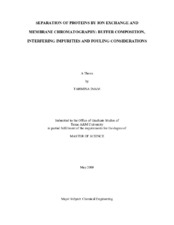| dc.contributor.advisor | Nikolov, Zivko | |
| dc.creator | Imam, Tahmina | |
| dc.date.accessioned | 2010-01-16T00:04:48Z | |
| dc.date.available | 2010-01-16T00:04:48Z | |
| dc.date.created | 2009-05 | |
| dc.date.issued | 2010-01-16 | |
| dc.identifier.uri | https://hdl.handle.net/1969.1/ETD-TAMU-2009-05-287 | |
| dc.description.abstract | Efficient separation of target protein from impurities is crucial in bioseparation for large
scale production and purity of the target protein. Two separation process approaches were
considered in this study. The first approach focused on identifying major impurity and
optimization of solution properties for target protein purification. The second approach
consisted of designing an adsorbent that interacted specifically with the target molecule.
The first study included modification of protein solution properties (pH, ionic strength,
buffer ions) in order to maximize lysozyme purification by a strong cation exchange resin.
The interaction of phytic acid, a major impurity, present in transgenic rice extracts, that
contributes to decreased lysozyme adsorption capacity on SP Sepharose was evaluated.
The target protein was lysozyme, which is used in a purified form as a baby formula
additive to reduce gastrointestinal tract infections. At constant ionic strength, lysozyme in
pH 4.5 acetate buffer had a higher binding capacity and stronger binding strength than at
pH 6.0. Lysozyme in sodium phosphate buffer of pH 6.0 exhibited lower adsorption
capacity than in pH 6 Tris buffer. Binding capacity and strength were significantly
affected by phytic acid in all studies buffers. The second study consisted of surface
modification of microfiltration membranes for protein purification and separation and
reduces fouling. This study describes adsorption and fouling of chemically modified
microfiltration membranes with bovine serum albumin (BSA) and immunoglobulin G
(IgG). Least fouling resulted with polyethylene glycol (PEG) membranes when BSA
protein was used. Amine-functionalized membranes showed specific interaction with
BSA. There was multi-layer deposition of IgG on amine-functionalized membrane. G3 membrane synthesized to selectively bind IgG seemed a noble option to separate IgG
from a protein mixture. | en |
| dc.format.mimetype | application/pdf | |
| dc.language.iso | en_US | |
| dc.subject | Lysozyme, Fouling, Microfiltration, Protein A mimetic ligand membrane | en |
| dc.title | SEPARATION OF PROTEINS BY ION EXCHANGE AND MEMBRANE CHROMATOGRAPHY: BUFFER COMPOSITION, INTERFERING IMPURITIES AND FOULING CONSIDERATIONS | en |
| dc.type | Book | en |
| dc.type | Thesis | en |
| thesis.degree.department | Chemical Engineering | en |
| thesis.degree.discipline | Chemical Engineering | en |
| thesis.degree.grantor | Texas A&M University | en |
| thesis.degree.name | Master of Science | en |
| thesis.degree.level | Masters | en |
| dc.contributor.committeeMember | Shantz, Daniel | |
| dc.contributor.committeeMember | El-Halwagi, Mahmoud | |
| dc.type.genre | Electronic Thesis | en |


